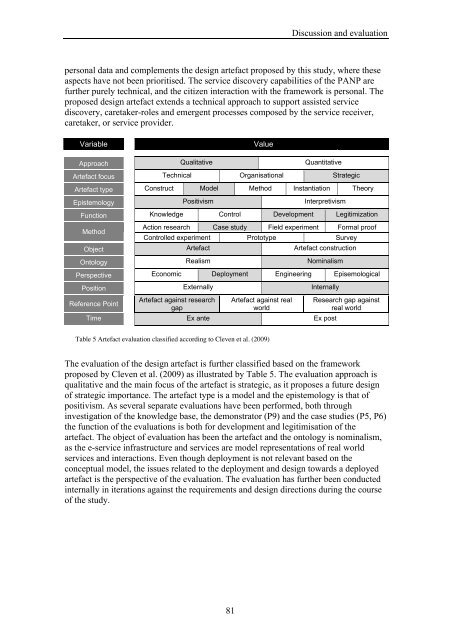Multi-channel provisioning of public services - Department of ...
Multi-channel provisioning of public services - Department of ...
Multi-channel provisioning of public services - Department of ...
Create successful ePaper yourself
Turn your PDF publications into a flip-book with our unique Google optimized e-Paper software.
Discussion and evaluation<br />
personal data and complements the design artefact proposed by this study, where these<br />
aspects have not been prioritised. The service discovery capabilities <strong>of</strong> the PANP are<br />
further purely technical, and the citizen interaction with the framework is personal. The<br />
proposed design artefact extends a technical approach to support assisted service<br />
discovery, caretaker-roles and emergent processes composed by the service receiver,<br />
caretaker, or service provider.<br />
Variable<br />
Value<br />
Approach Qualitative Quantitative<br />
Artefact focus Technical Organisational Strategic<br />
Artefact type Construct Model Method Instantiation Theory<br />
Epistemology Positivism Interpretivism<br />
Function Knowledge Control Development Legitimization<br />
Method<br />
Action research Case study Field experiment Formal pro<strong>of</strong><br />
Controlled experiment Prototype Survey<br />
Object Artefact Artefact construction<br />
Ontology Realism Nominalism<br />
Perspective Economic Deployment Engineering Episemological<br />
Position Externally Internally<br />
Reference Point<br />
Artefact against research<br />
gap<br />
Artefact against real<br />
world<br />
Time Ex ante Ex post<br />
Research gap against<br />
real world<br />
Table 5 Artefact evaluation classified according to Cleven et al. (2009)<br />
The evaluation <strong>of</strong> the design artefact is further classified based on the framework<br />
proposed by Cleven et al. (2009) as illustrated by Table 5. The evaluation approach is<br />
qualitative and the main focus <strong>of</strong> the artefact is strategic, as it proposes a future design<br />
<strong>of</strong> strategic importance. The artefact type is a model and the epistemology is that <strong>of</strong><br />
positivism. As several separate evaluations have been performed, both through<br />
investigation <strong>of</strong> the knowledge base, the demonstrator (P9) and the case studies (P5, P6)<br />
the function <strong>of</strong> the evaluations is both for development and legitimisation <strong>of</strong> the<br />
artefact. The object <strong>of</strong> evaluation has been the artefact and the ontology is nominalism,<br />
as the e-service infrastructure and <strong>services</strong> are model representations <strong>of</strong> real world<br />
<strong>services</strong> and interactions. Even though deployment is not relevant based on the<br />
conceptual model, the issues related to the deployment and design towards a deployed<br />
artefact is the perspective <strong>of</strong> the evaluation. The evaluation has further been conducted<br />
internally in iterations against the requirements and design directions during the course<br />
<strong>of</strong> the study.<br />
81
















